07 Divide and Conquer
1 Intro#
- The maximum subsequence sum
- \(T(N)=2T(N/2)+O(N)\)
- \(T(N)=O(N\log N)\)
- Tree traversals
- \(T(N)=2T(N/2)\)
- \(T(N)=O(N)\)
- Mergesort and quicksort
- \(T(N)=2T(N/2)+O(N)\)
- \(T(N)=O(N\log N)\)
出发点:递推公式
1.1 Example: Closest Points Problem#
Question
一个平面上有 \(N\) 个点,找到距离最近的一对点
- Divide
- 找到一条直线,平分所有点 re
- 变成两个子问题
- Conquer
- 若子问题中找到的最小距离为 \(\delta\),在分割直线左右两侧 \(\pm \delta\) 范围内查找是否有更小的距离
- problem: 如何减小合并的复杂度?
Solution
按照一个方向坐标大小进行排序,然后顺序遍历,如果相邻的两个节点在这个方向上距离小于 \(\delta\),才考虑它们之间的距离,并更新点对和 \(\delta\)
这样就是 \(O(N)\)
\(T(N)=2T(N/2)+O(N)=O(N\log N)\)
优化前后时间复杂度推导和对比
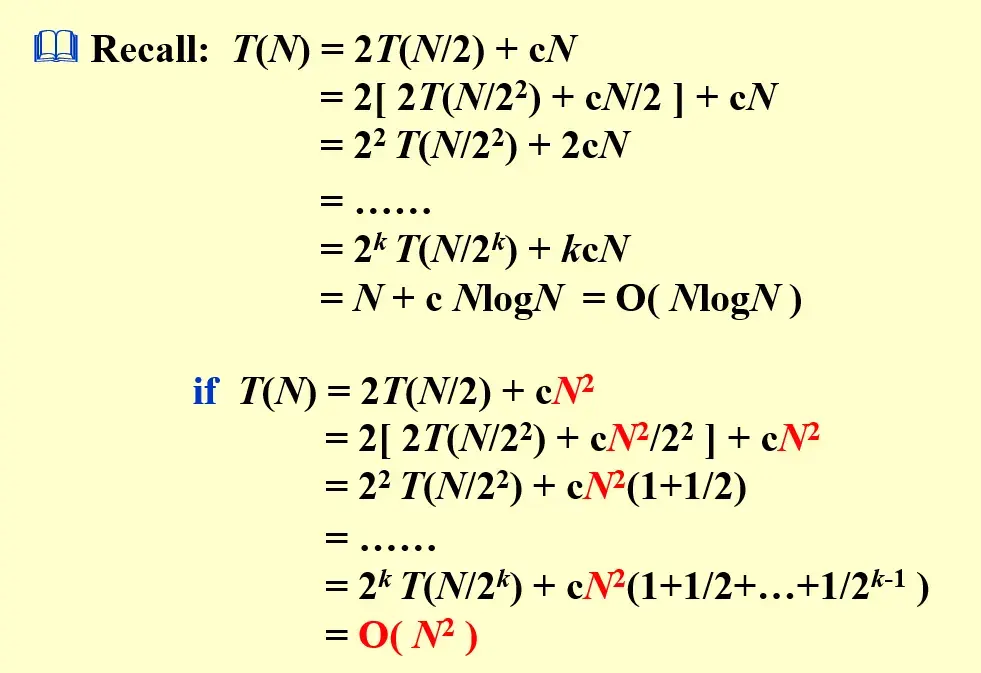
2 Solving Recurrences#
- Three methods for solving recurrences
- Substitution method 代换法
- Recursion-tree method 递归树法
- Master method 主方法
- Details to be ignored
- if \(N/b\) is int or not
- always assume \(T(n)=\Theta(1)\) for small \(n\)
2.1 Substitution Method#
进行猜测,然后使用归纳法证明,方便用于验证
Example
假设对于所有 \(m<N\) 都成立,那么当 \(m=\lfloor N/2 \rfloor\) 时也成立,即存在常数 \(c\geq 1\) 使得:
那么:
由此完成归纳,证毕。
Attention
可以选择足够大的常数 \(c\),使得假设对于 \(N=1\) 等较小的 case 也一定成立
Exact form
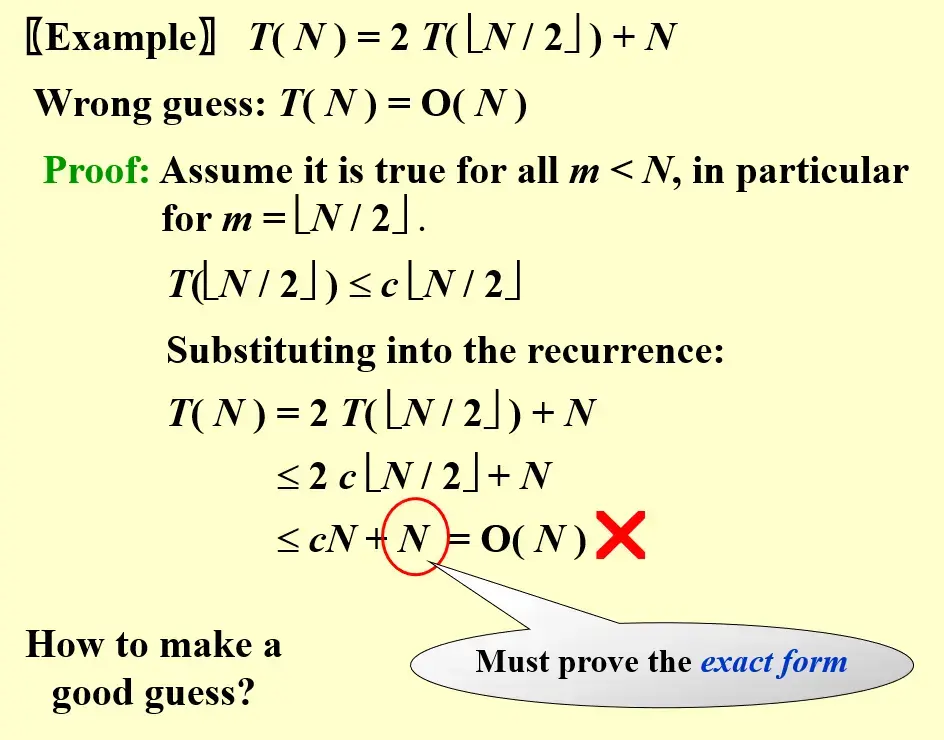 放缩的时候必须确保常数不会变大
放缩的时候必须确保常数不会变大
2.2 Recursion-tree Method#
Example
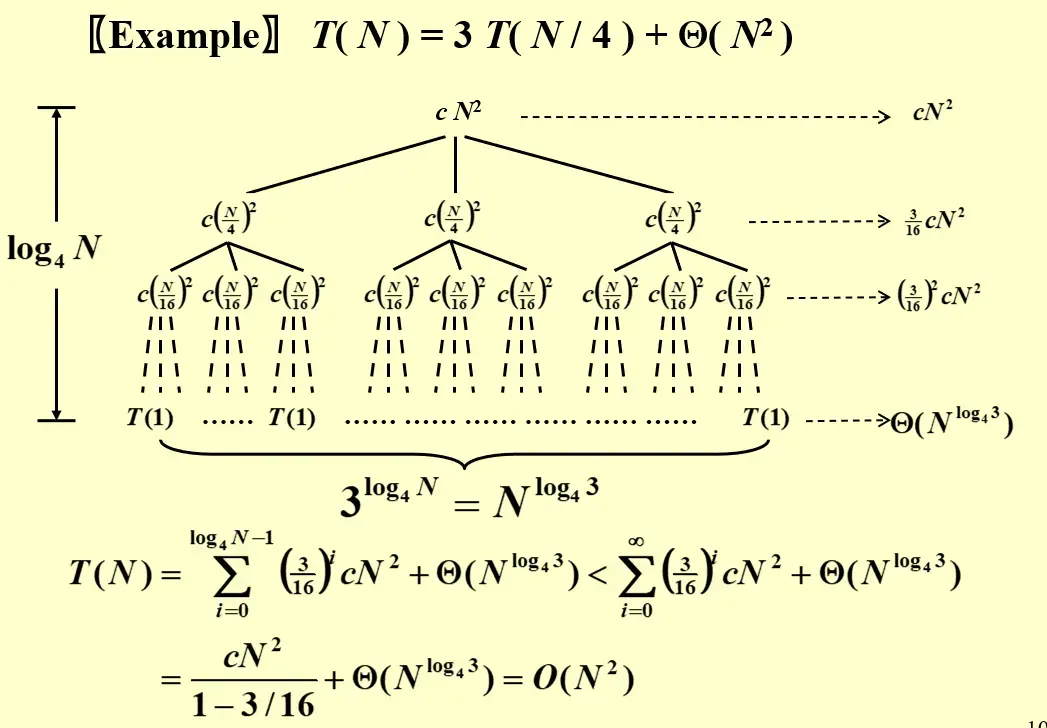
不一定适用于所有情况!
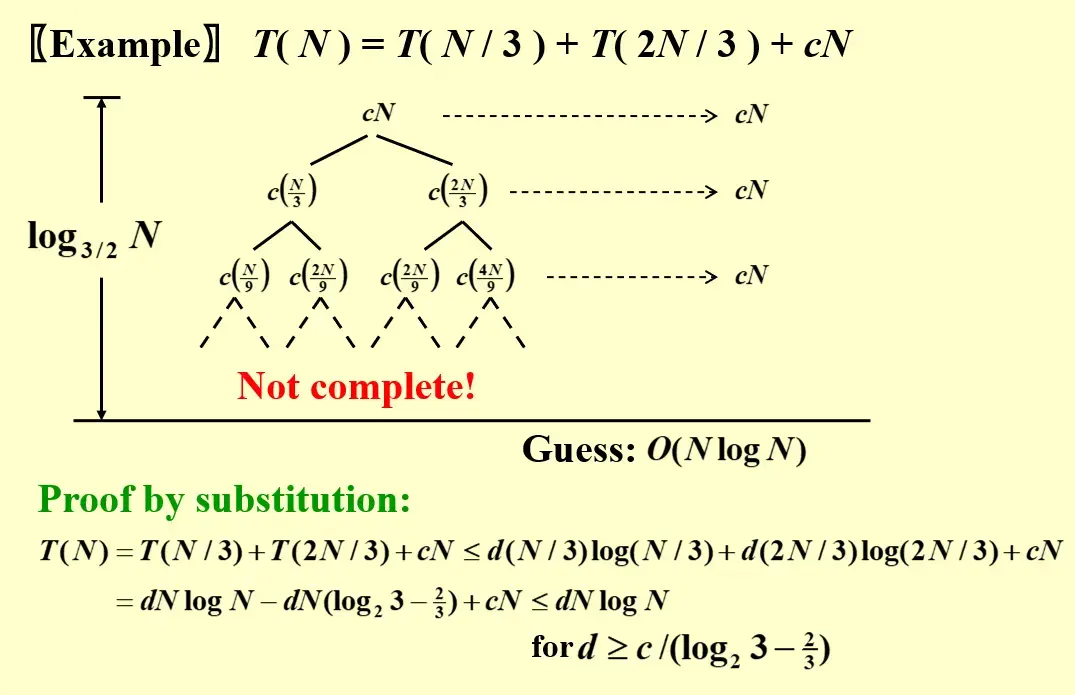 这里展开之后是斜树,可以计算但比较麻烦
这里展开之后是斜树,可以计算但比较麻烦
比较新颖的一道题

- 核心思路是一样的,找出叶子的数量和分叉的数量,计算和比较开销
- 这里不是每层开销不是一个单位时间,而是本层的节点数量,所以答案应该是 \(O(M \cdot 8^{\log_{2}n/\sqrt{ M }}+\frac{8^{\log_{2}n/\sqrt{ M }}-1}{8-1})=O(M \cdot 8^{\log_{2}n/\sqrt{ M }})=O(n^3/\sqrt{ M })\)
2.3 Master method#
2.3.1 form 1#
对于递推式 \(T(N)=aT(N/b)+f(N)\),有:
- 如果 \(f(N)=O(N^{\log_{b}a-\epsilon}\)),即 \(f(N)\) 的阶低于 \(\log_{b}a\),那么 divide 是主要开销,\(T(N)=\Theta(N^{\log_{b}a})\)
- 如果 \(f(N)=\Theta(N^{\log_{b}a})\),即二者开销同阶,\(T(N)=\Theta(N^{\log_{b}a}\log N)\)
- 如果 \(f(N)=\Omega(N^{\log_{b}a+\epsilon})\),即 \(f(N)\) 的阶高于 \(log_b a\),且 \(af(N/b)<cf(N)\) (regularity condition),那么 conquer 是主要开销,\(T(N)=\Theta(F(N))\)
Attention
无法覆盖所有条件,例如 \(T(N)=2T(N/2)+N\log N\) 不满足任何一种条件,但是可以使用 2.3.4 form 3 来解决
Regularity Condition 的作用
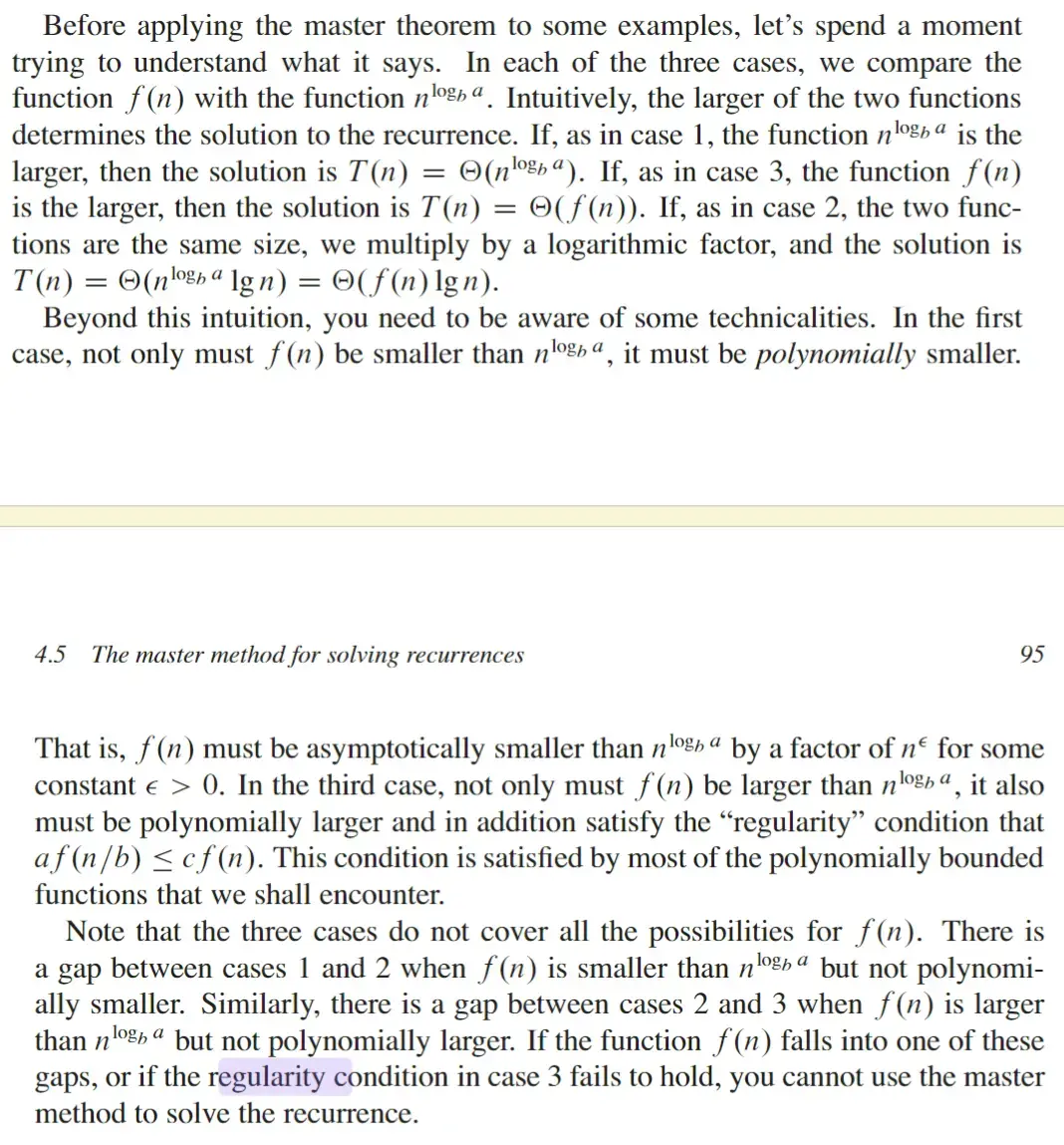
Polynomially smaller
Polynomially smaller 是指一个函数与另一个函数相比,在增长速率上相差一个多项式级别。
具体来说,如果有两个函数 \( f(n) \) 和 \( g(n) \),我们说 \( f(n) \) polynomially smaller(多项式级别小)于 \( g(n) \),意味着存在某个多项式函数 \( n^k \),使得
换句话说,\( f(n) \) 的增长速率比 \( g(n) \) 慢,并且相差一个多项式因子 \( n^k \),其中 \( k \) 是一个常数。
举例
-
\( f(n) = n \) 和 \( g(n) = n^2 \): 在这种情况下,\( f(n) \) 是 \( g(n) \) 的多项式级别小,因为 \( n = O\left(\frac{n^2}{n}\right) \),这里 \( k = 1 \),所以 \( n \) 是 \( n^2 \) 的多项式级别小。
-
\( f(n) = n \) 和 \( g(n) = n^3 \): 这里 \( f(n) \) 也是 \( g(n) \) 的多项式级别小,因为 \( n = O\left(\frac{n^3}{n^2}\right) \),这里 \( k = 2 \),所以 \( n \) 是 \( n^3 \) 的多项式级别小。
为什么多项式级别小很重要?
在算法分析中,特别是递归分析或分治算法的分析中,多项式级别小的概念经常用来比较递归关系中不同部分的增长速率。比如:
- 在 Master Theorem 中,当你分析递归关系时,会比较子问题的数量(即递归部分)与额外的工作量(即合并部分)。如果合并部分(比如 \( f(n) \))在某一层比递归部分(比如 \( aT(n/b) \))要小得多,那么可以认为这个合并部分是 多项式级别小,递归部分占主导地位。
- 反之,如果 \( f(n) \) 增长得与递归部分差不多或者更快,那么合并部分会成为主要开销,这时就会有不同的时间复杂度分析。
总结
"Polynomially smaller" 就是指在增长速度上,两个函数相差一个多项式的级别。这个概念在分析算法和递归关系时经常出现,帮助我们判断哪些部分在整体复杂度中占主导地位,哪些部分可以忽略掉。
2.3.2 Prove by Recursion-tree#
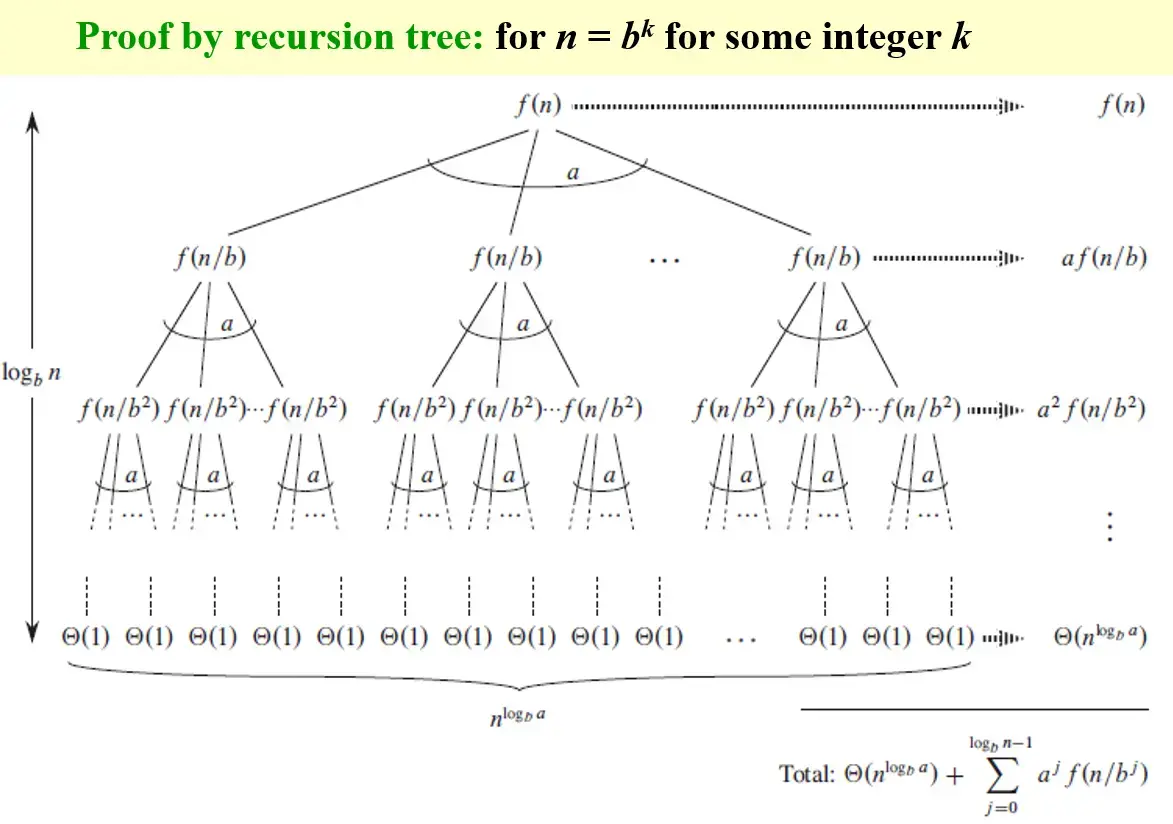
2.3.3 form 2#
- 如果存在常数 \(k<1\),使得 \(af(N/b)=kf(N)\),那么 \(T(N)=\Theta(f(N))\)
- 如果存在常数 \(K>1\),使得 \(af(N/b)=Kf(N)\),那么 \(T(N)=\Theta(N^{\log_{b}a})\)
- 如果 \(af(N/b)=f(N)\),那么 \(T(N)=\Theta(f(N)\log_{b}N)\)
Attention
这种形式的适用范围没有前一种那么广,例如:
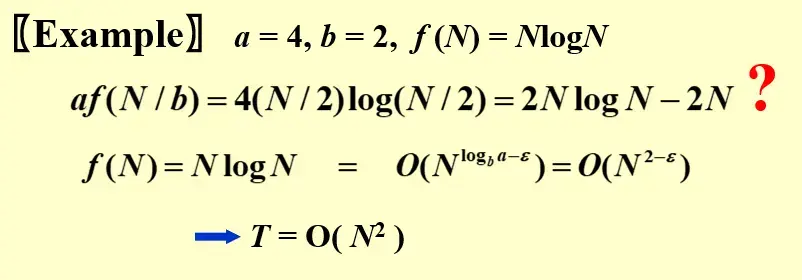
2.3.4 form 3#
当 \(a\ge 1,b\geq 1, p\geq 0\) 时,对于递推式:
- if \(a>b^k\), \(T(N)=O(N^{\log_{b}a})\)
- if \(a=b^k\), \(T(N)=O(N^k \log^{p+1}N)\)
- if \(a<b^k\), \(T(N)=O(N^k \log^p N)\)
Important
这种形式的使用场景最广,但仍然可以进行以下推广,使 \(p\) 为任意实数,则:
- if \(a<b^k\), then
- if \(p<0\), \(T(N)=\Theta(N^k)\)
- if \(p\geq 0\), \(T(N)=\Theta(N^k\log^pN)\)
- if \(a=b^k\), then
- if \(p<-1\), \(T(N)=\Theta(N^k)\)
- if \(p=-1\), \(T(N)=\Theta(N^k\log \log N)\)
- if \(p>-1\), \(T(N)=\Theta(N^k\log^{p+1}N)\)
- if \(a>b^k\), \(T(N)=\Theta(N^{\log_{b}a})\)
3 Discussion#
3.1 Three-way-mergesort#
Question
Three-way-mergesort : Suppose instead of dividing in two halves at each step of the mergesort, we divide into three one thirds, sort each part, and finally combine all of them using a three-way-merge.
What is the overall time complexity of this algorithm for sorting n elements? Prove it.
How about \(k\)-way merge?
\(T(n)=kT(n/k)+O(n)\), where \(O(n)\) is merge time.
By Master theorem, \(a=k\), \(b=k\), \(f(n)=O(n)\), making \(\log_{b}a=1\), the recurrence relation falls under Case 2 of Master theorem, thus \(T(n)=\Theta(n^1\log n)=\Theta(n\log n)\)
3.2 Solve this recursion beyond master theorem#
Question
\(T(n)=2T(|\sqrt{ n }|)+\log n\)
Let \(m=\log n\),
thus \(T(n)=2T(\sqrt{ n })+\log n \Rightarrow T(e^m)=2T(e^{m/2})+m\);
Let \(T_{1}(m)=T(e^m)\),
thus \(T_{1}(m)=2T_{1}(m/2)+m\);
By Master theorem, \(T_{1}(m)=T(e^m) = O(m\log m)\),
thus \(T(n)=O(\log n \cdot \log \log n)\)
conclusion
遇到 \(\sqrt{ N }\) 之类的,就进行代换
4 Questions#
4.1 Q7#
4.1.1 More about cloest pair of points#
If devide-and-conquer strategy is used to find the closest pair of points in a plane, unless the points are sorted not only by their \(x\) coordinates but also by their \(y\) coordinates, it would be impossible to solve it in a time of \(O(N\log N)\), where \(N\) is the number of points.
Answer
T why? 难道不能先进行一个 \(O(N\log N)\) 的排序吗
4.2 HW7#
4.2.1 Master theorem form3 利用#
When solving a problem with input size \(N\) by divide and conquer, if at each stage the problem is divided into 8 sub-problems of equal size \(N/3\), and the conquer step takes \(O(N^2logN)\) to form the solution from the sub-solutions, then the overall time complexity is __.
Answer
\(O(N^2\log N)\) 因为 \(T(N)=8T(N/3)+O(N^2\log N)\),其中 \(a=8,b=3,k=2,p=1\) 由于 \(a<b^k\),所以 \(T(N)=O(N^k\log^pN)=O(N^2\log N)\)
4.3 Ex7#
4.3.1 从代码使用 Master Theorem#
Consider the following function, where the time complexity for function calc() is \(O(1)\).
Assume the initial input is l=1, r=N, What is the running time of this function? Your answer should be as tight as possible.
Answer
\(O(N^2\log^2N)\)
- Divide: 进行 4 次递归调用,每次的序列长度为 \(N/2\)
- Conquer:
for (int k = 1; k <= r - l + 1; k++)这里有 \(N\) 次for (int i = 1; i <= r - l + 1; i++) for (int j = l; j <= r - l + 1; j += i)这里其实是 \(N(1+1/2+1/3+\dots+1/N)=N\log N\)- 因此,conquer 的总花销是 \(N^2\log N\)
- 依据 2.3.4 form 3 \(a=b^k\) 情况,得到 \(O(N^2\log^2N)\)